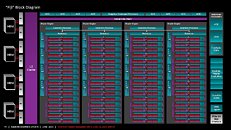- Joined
- Oct 9, 2007
- Messages
- 47,878 (7.38/day)
- Location
- Dublin, Ireland
| System Name | RBMK-1000 |
|---|---|
| Processor | AMD Ryzen 7 5700G |
| Motherboard | Gigabyte B550 AORUS Elite V2 |
| Cooling | DeepCool Gammax L240 V2 |
| Memory | 2x 16GB DDR4-3200 |
| Video Card(s) | Galax RTX 4070 Ti EX |
| Storage | Samsung 990 1TB |
| Display(s) | BenQ 1440p 60 Hz 27-inch |
| Case | Corsair Carbide 100R |
| Audio Device(s) | ASUS SupremeFX S1220A |
| Power Supply | Cooler Master MWE Gold 650W |
| Mouse | ASUS ROG Strix Impact |
| Keyboard | Gamdias Hermes E2 |
| Software | Windows 11 Pro |
A Linux patch for AMD's GPU drivers reveals that its upcoming "Vega 10" graphics processor bears numeric core-configuration similarities to the "Fiji" silicon which drives the enthusiast-segment Radeon R9 Fury series graphics cards. The patch bears configuration values which tell the software how to utilize the resources on the GPU, by spelling them out. The entry "gfx.config.max_shader_engines = 4," for example, indicates that "Vega 10" features four shader engines, like "Fiji." Another entry "Adev-> gfx.config.max_cu_per_sh = 16" signifies the number of GCN compute units (CUs) per shader engine. Assuming the number of stream processors per CU hasn't changed from 64 in the "Vega" architecture, we're looking at a total stream processor count of 4,096. This could also put the TMU count at 256.
At earlier reveals of the "Vega 10" package, you notice a large, somewhat square GPU die neighboring two smaller rectangular memory stack dies, which together sit on a shiny structure, which is the silicon interposer. The presence of just two memory stack dies sparked speculation that "Vega 10" features a narrower 2048-bit memory interface compared to the 4096-bit of "Fiji," but since the memory itself is newer-generation HBM2, which ticks at higher clocks, AMD could run them at double the memory clock as "Fiji" to arrive at the same 512 GB/s bandwidth. The 4,096 stream processors of "Vega 10" are two generations ahead of the ones on "Fiji," which together with 14 nm process-level improvements, could run at much higher GPU clocks, making AMD get back into the high-end graphics segment.

View at TechPowerUp Main Site
At earlier reveals of the "Vega 10" package, you notice a large, somewhat square GPU die neighboring two smaller rectangular memory stack dies, which together sit on a shiny structure, which is the silicon interposer. The presence of just two memory stack dies sparked speculation that "Vega 10" features a narrower 2048-bit memory interface compared to the 4096-bit of "Fiji," but since the memory itself is newer-generation HBM2, which ticks at higher clocks, AMD could run them at double the memory clock as "Fiji" to arrive at the same 512 GB/s bandwidth. The 4,096 stream processors of "Vega 10" are two generations ahead of the ones on "Fiji," which together with 14 nm process-level improvements, could run at much higher GPU clocks, making AMD get back into the high-end graphics segment.

View at TechPowerUp Main Site






